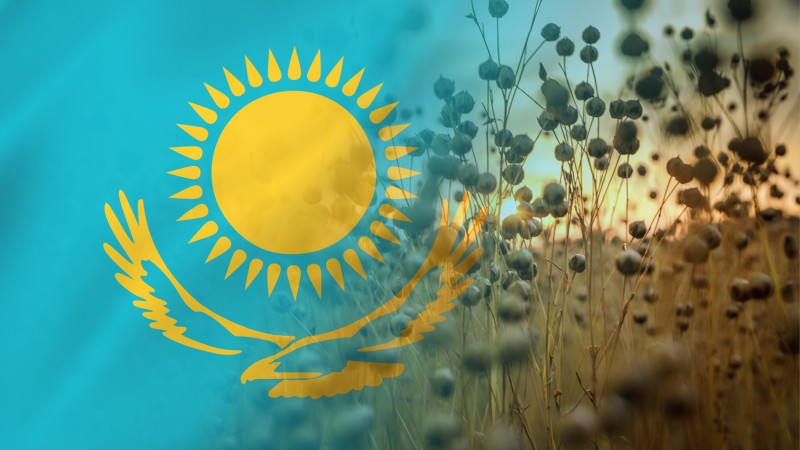Flaxseed: "A reduction in acreage is likely”
January 4, 2023 at 1:00 PM ,
Der AUDITOR

Which were the major difficulties faced by the Kazakh flaxseed market in 2022? Were they mainly caused by the ongoing threat of the Ukraine war and the resulting energy crisis and inflation, or do you think they would have occurred in a calmer year as well?
External and internal factors had the biggest impact on the Kazakh flaxseedseed market in the 2021/22 season. By far the most important external factor was the war in Ukraine, which started in February. As a result, there was further disruption to logistical supply chains for commodities that had not recovered from the coronavirus pandemic and quarantines, as well as a sharp increase in energy and logistics costs. As a result, prices for basic agricultural products such as wheat, corn, barley, soybeans, sugar, etc., as well as for the raw materials used to produce vegetable oils and for the oils themselves, rose. The sanctions imposed on Russia have intensified and exacerbated this process. Global inflation also contributed significantly to the price increase.
All these processes are reflected in Kazakhstan's agricultural market. Domestic factors include the 2021 drought, which led to a significant decline in yields of the main cereals and oilseeds in Kazakhstan. As a result, and due to a significant increase in the cost of agricultural inputs (seeds, fertilisers, pesticides, fuel, spare parts, etc.), production costs have risen significantly. The introduction of export duties and restrictions on cereals, oilseeds and vegetable oils in Russia has increased demand for Kazakh products. The Kazakh government also imposed export restrictions on wheat, flour, sunflower seeds and sunflower oil to ensure food security and combat food inflation.
Similar processes took place in the flaxseed market. Despite the increase in production in Russia in the 2021/22 marketing year by 452,000 mt to 1.24 million mt (Kazakh Grain Union estimates) and the decrease in production in Kazakhstan to 776,000 mt (-282,000 mt yoy) and in Canada to 346,000 mt (-232,000 mt yoy), the overall balance of global supply remained unchanged.
Experts predict that the 2022/23 marketing year will see a significant increase in production from the most important producers: Russia +210,000 mt, Kazakhstan +250,000 mt, Canada +74,000 mt. Global production is expected to reach a record 3.676 million mt (+417,000 mt yoy), with processing increasing by only 90,000 mt. The market for flaxseed and flaxseed oil, already under the influence of prices for other vegetable oils, will continue to be impacted.
|
Global flaxseed production, in mt |
||||
|
Country |
2019/20 |
2020/21 |
2021/22 |
2022/23* |
|
Russia |
651,000 |
788,000 |
1,240,000 |
1,450,000 |
|
Kazakhstan |
1,007,000 |
1,058,000 |
776,000 |
1,026,000 |
|
Canada |
486,000 |
578,000 |
346,000 |
420,000 |
|
China |
360,000 |
360,000 |
340,000 |
360,000 |
|
USA |
162,000 |
145,000 |
70,000 |
110,000 |
|
Others |
402,000 |
433,000 |
487,000 |
310,000 |
|
Total |
3,068,000 |
3,362,000 |
3,259,000 |
3,676,000 |
|
Oil World, Russia Statistics - Rosstat; Bureau of National statistics Kazakhstan *forecast |
||||
Which effects of the coronavirus pandemic are still noticeable?
The impact of the coronavirus pandemic and quarantines is still being felt in the flaxseed market in Kazakhstan. In addition to the significant logistical costs, a strict quarantine was imposed in China during the pandemic. As a result, no Kazakh flaxseed was shipped between November 2020 and April 2021, and many exporters had to return loaded wagons that had been at the border for 5-6 months. Exporters were saved from significant losses by the rise in flaxseed prices in spring 2021. From summer 2021, the Chinese authorities agreed to deliver flaxseed in containers. However, the cost of such shipments is significantly higher and there is a shortage of containers and wagons to transport them. In addition, the cargo has to wait a long time at the border for sanitation and transhipment onto the Chinese railway tracks. This situation can still be observed today, and as a result, exports of flaxseed from Kazakhstan to China could have been much larger. Instead, China's needs were met by Russian suppliers who were able to achieve record exports.
|
Kazakh flaxseed exports, in mt |
||||
|
Destination |
2018/19 |
2019/20 |
2020/21 |
2021/22 |
|
Belgium |
245,800 |
170,000 |
125,600 |
164,500 |
|
China |
0 |
104,200 |
109,500 |
112,600 |
|
Poland |
84,600 |
65,700 |
66,300 |
70,100 |
|
Afghanistan |
54,500 |
34,300 |
18,000 |
30,000 |
|
Turkey |
800 |
8,000 |
4,600 |
23,100 |
|
Germany |
22,600 |
25,500 |
22,400 |
18,700 |
|
Russia |
16,700 |
34,400 |
27,300 |
15,600 |
|
Others |
71,400 |
41,600 |
25,800 |
29,500 |
|
Total |
496,400 |
483,700 |
399,500 |
464,100 |
|
State Revenue Committee under the Ministry of Finance of the Republic of Kazakhstan and Eurasian Commission; Sep-Aug |
||||
Apparently, Russian exporters have managed to better adapt to the quarantine requirements of the Chinese authorities. In addition, the sanctions imposed on Russia have made it much more difficult for Russian flaxseed to access the European market in the 2021/22 marketing year. Therefore, demand from China has significantly facilitated flaxseed exports from Russia.
Despite the sanctions, it should be noted that Russian flaxseed exports reached record levels in the 2021/22 marketing year due to the good crop in Russia. For the 2022/23 marketing year, it is unlikely that exports of flaxseed from Russia will reach such figures despite increased production. Sanctions related to ship and cargo insurance, a ban on Russian transporters and wagons entering the EU, and difficulties in payment processing (sanctions against Russian banks) will not allow large-scale deliveries to the EU market. The missing quantities of flaxseed in the 2022/23 marketing year will be supplied from Kazakhstan and Canada.
|
Russian flaxseed exports, in mt |
||||
|
Destination |
2018/19 |
2019/20 |
2020/21 |
2021/22* |
|
China |
117,600 |
199,000 |
298,200 |
476,000 |
|
Belgium |
193,800 |
197,200 |
152,700 |
220,000 |
|
Turkey |
26,300 |
7,500 |
4,300 |
112,000 |
|
Latvia |
12,600 |
10,800 |
21,400 |
80,000 |
|
Italy |
15,200 |
24,300 |
24,600 |
18,000 |
|
Poland |
20,900 |
26,200 |
27,000 |
29,800 |
|
Others |
54,700 |
53,700 |
29,700 |
39,200 |
|
Total |
441,100 |
518,700 |
557,900 |
975,000 |
|
Federal Customs Service (FCS) of Russian Federation; International Trade Centre (ITC), www.trademap.com; Jul-Jun |
||||
In most markets, prices for feed and food commodities have increased significantly compared to last year. Kazakh flaxseed is no exception here. Do you think that buyers will have to adjust to these higher prices in the long term, or do you expect prices to decline again?
The upward trend in flaxseed prices began in September 2020 against the backdrop of the global coronavirus pandemic, quarantines and closures, and supply chain disruption. As a result, logistics costs and prices for the entire group of food, energy resources, oil, vegetable oils and raw materials for their production increased. And with it, the price of flaxseed in Europe increased from USD 531/mt in August 2020 to USD 846/mt in March 2021, CIF NWE. Prices stabilised until August 2021 and then, against a backdrop of rising inflation, ongoing logistics problems and drought for major producers in Kazakhstan and Canada, began to rise again, reaching USD 953/mt in November. After a brief stabilisation in late 2021/early 2022, following the start of the war in Ukraine, prices reached their record high of USD 1,047/mt in March 2022. As a result of a technical correction, prices fell again to USD 898/mt in May 2022.
The downward trend in flaxseed prices began in the summer of 2022 for the following reasons:
- Adjustment of the world economy to the consequences of the pandemic and the war in Ukraine, decrease in the prices of oil and vegetable oils (especially palm and soybean oil), resumption of exports of cereals and oilseeds, oils, meal and cake from Ukrainian ports within the framework of the "cereal corridor" in accordance with the agreements between the United Nations, Turkey, Ukraine and Russia as of August 2021
- a sharp increase in flaxseed acreage in Russia
- the prospect of good crops in other main growing countries
As a result, flaxseed prices started to fall rapidly, reaching USD 585/mt in November 2022, the lowest level since September 2020. A similar situation was observed in other markets. This trend will continue in the longer term if there is no further escalation of the situation in Ukraine and prices could remain at the current level for the time being until summer 2023.
Furthermore, climate change and crop problems are real and pose a threat to all types of food and feed around the world and will most likely continue to do so. How would this affect the Kazakh flaxseed market in the future and what could businesses in this industry do to improve this situation?
Due to increased production costs, simultaneously decreased market prices and a large production in Russia, it is likely that the acreage in Kazakhstan will decrease by 10-15% from 1.35 million ha to 1.15-1.20 million ha next year, the last time such a small space was cultivated in 2019. Due to the dry weather conditions of the last three years, additional agro-technical measures had to be taken, for which not all farmers had the necessary means and skills. The attached chart clearly shows that an expansion of flaxseed areas does not lead to an increase in production, but rather has the opposite effect.
Considering the current crises (pandemic, energy, wars, climate change etc.), what do you think the Kazakh flaxseed market has to prepare for in the coming year? Are there any major consequences to be expected for the 2023/2024 season in terms of supply and demand?
The geopolitical situation in the world will continue to have a significant impact on energy and food markets next year. The sowing campaign in the main flaxseed producing countries will start in May. By then, the main trends in the flaxseed market will be clear. Given the continued demand, low prices and large stocks, a 10-15% reduction in acreage in the main producing countries is likely.





